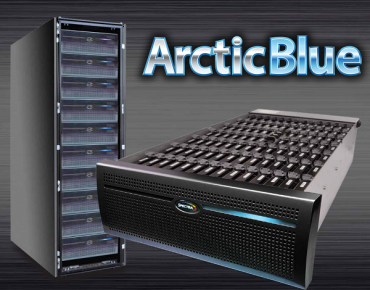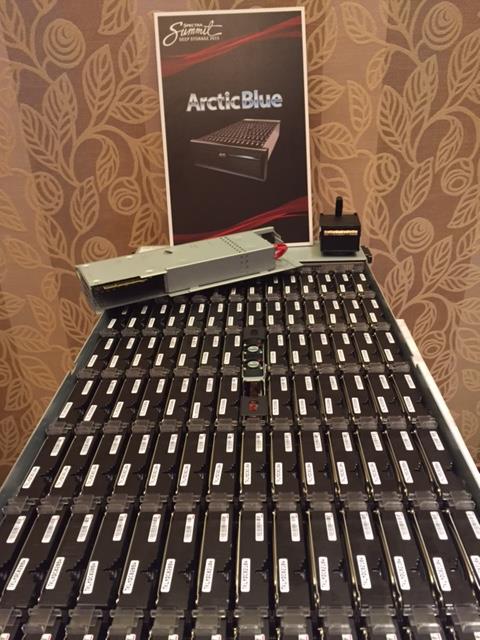Spectra Logic Ushers in Nearline Disk at 10 Cents/GB

At SpectraSummit held in Boulder, Colorado, this week, Spectra Logic debuted a new nearline disk storage system, called ArcticBlue, which snaps into the company’s BlackPearl hybrid storage architecture to create an object storage based disk platform that ticks three primary boxes: longevity, efficiency and cost effectiveness. Spectra has purpose built this product for a variety of use cases and verticals, including private cloud, media and entertainment, high-performance computing, video surveillance, and life sciences.
With the digital universe set to balloon to 40 zettabytes by 2020, according to analyst firm IDC, and more use cases evolving every day pushed by IoT proliferation, exploding machine data, and the tremendous growth in areas such as genomics, video surveillance and geospatial, the save-everything paradigm is nigh upon us. Plus with innovative analytics use cases being born every day, yesterday's junk is tomorrow's gold, but cost and ease-of-use so far haven't lined up to support this mandate.
"Imagine never having to delete your data," Spectra Logic's senior director of product management David Feller prompted the audience. "Our goal is the longevity very near the cost of tape with the longevity of tape. ...We're talking about a new category, specifically a seven-year disk product with very good online performance of at least a GB/second or more with really incredible power consumption and density."
With its "Deep Storage" system, that now includes the nearline disk-based ArticBlue element, Spectra says it has achieved:
• Long term disk – 7 years.
• Online performance > 1GB/s, random access across all bands and across all nodes.
• Power, density, service efficiency.
• As low as 10₵ per Gigabyte – US.
 To understand ArticBlue, you have to understand Spectra's BlackPearl gateway. Announced in 2013, BlackPearl is an intelligent controller that uses an extension of the S3 cloud storage interface to enable a RESTful, object-based interface to deep storage. The appliance was designed for very large data sets that scale from hundreds of terabytes up to petabyte or exabyte in scale.
To understand ArticBlue, you have to understand Spectra's BlackPearl gateway. Announced in 2013, BlackPearl is an intelligent controller that uses an extension of the S3 cloud storage interface to enable a RESTful, object-based interface to deep storage. The appliance was designed for very large data sets that scale from hundreds of terabytes up to petabyte or exabyte in scale.
"For the last 36 years we have been doing tape, so the question is 'How do I make tape easy? How do I take all those issues around how to control a robot, collecting the data and string it to those drives appropropriately so the library works well?'" asked Feller. Spectra's strategy was to take its vision of simplicity, scalability, addressibility and enable these benefits in its private cloud through BlackPearl.
"BlackPearl provides a simple approach to not just a cloud-like storage place but to archive it in an object methodology for great scalability," Feller explained. "The S3 integration is the mechanism for getting a file-based workflow into a more cloud-like environment."
"In between this interface and tape, there is a need for the ability to control the remotes and to cache the data in a fast way, and also an object database to keep track of every object," he continued. "They key is for all those features and functions to interface beween the S3 front-end and the deep storage back end, which until today has been tape. This is all contained inside of BlackPearl."
With the introduction of ArticBlue, long-life nearline disk is added to this equation. It is SAS-based disk, or a PIN cache if you will, for data that is accessed more often. By leveraging BlackPearl’s new Advanced Bucket Management (ABM) feature, one or more copies can be created on both ArcticBlue disk systems and Spectra Logic tape libraries.
Spectra is offering random access across any of the bands and chassis and trying to eliminate three-year obselescence cycle of traditional disk drives, explained Feller. The key to ArticBlue's longevity is a drive lifecycle management implementation that straddles two main technologies:
+ SMR: Shigled media with overlapping tracks
+ Extend life through power down, read/write control
Drive lifecycle management comes from the tape world, where a spare tape drive is kept on-hand so that if something goes wrong, the spare is right there. While the approach comes from tape, a similar principle can be applied to drives. Spectra is also carefully controlling how that disk operates, which ties into a technology that Spectra introduced with its VERDE DPE product, called Shingled Magnetic Recording (SMR) Drives.
Shingled Magnetic Recording enables more data to be written on a drive without increasing size or form factor. With the SMR technology, tracks are partially overwritten. A normal drive can fill holes at random, but with SMR, the drive has to move overlaying tracks. Spectra's Feller explained that SMR drives take some special handling. They like to be written to sequentially, in large blocks, and don’t really like to have a lot of deletes or random changes. "And that," he declared pointedly, "sounds a lot like a tape drive."
BlackPearl uses a large and fast cache that offers the ability to forcefully make the data sequential and force it to be written off the SMR drives in order, explained Feller. And because of BlackPearl and the RESTful S3 interface, powering up and down is possible, something file-based systems wouldn't tolerate.
The ArticBlue system is essentially a very large bank of 8TB SMR drives with one 4U node arranged into four bands. Spectra uses the equivalent of triple-parity local erasure code (through ZFS) to maximize data integrity. Under this system, a 20+3 band size is used, however each band of 24 drives (192TB) also includes 1 global spare. If a drive failure occurs, the array immediately activates a global spare. When the failed drive is replaced, the replacement drive becomes the global spare.
The first expansion (to the BlackPearl controlled master node) involves buying two bands (48 drives), so that one can be powered down, which enables the longevity feature. After the first two bands, additional bands can be purchased one at a time.
A full 4U node (96 drives) provides 768TB raw capacity and 640TB usable capacity uncompressed and sells for $76,800. A full rack (8x4U units) achieves 6.1PB (raw). Compression is on by default as the processor is said to enable compression faster than write.
The ability to power down decreases operating expenses and lowers power by as much as 70 percent according to the company over the full unit being on at the same time. One 4U node draws 750 watts in full read/write mode. Adding a second copy on ejected tape only costs about 2₵/GB, which comes out to about 12-13₵/GB for two copies.
The takeaway is that the combination of BlackPearl and ArticBlue provides another tier between online and tape storage that is cost-effective and scalable. Spectra Logic CEO Nathan Thompson characterized this as "a breakthrough product that fills an open segment in private cloud, object, nearline and archive storage." Availability begins in December 2015.
Related
With over a decade’s experience covering the HPC space, Tiffany Trader is one of the preeminent voices reporting on advanced scale computing today.










